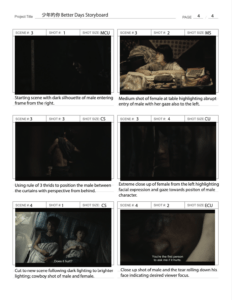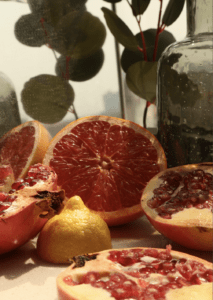Concept & Story
What is the concept & the story in your project?
The narration we chose is the opening monologue of the famous musical Tick, Tick, Boom!. The musical is created by composer Jonathan Larson based on his own true story. At the time in the musical, Jonathan is turning 30 in one week. He has been working as a waiter to pay his bills while writing a musical throughout his best years. The musical is also being presented in one week. He kept hearing this ticking, informing him he’s running out of time to actually make something and be somebody, he’s also expecting that sound of “boom”, that day he becomes something big. The anxiety as well as the anticipation of a man who is struggling in life pursuing his dream is what our project is about.
The true story is, this musical he was making didn’t make it, but he never stopped writing, and years later, the day actually came, he wrote his most famous piece Rent, which is one of the most renowned musicals in the history of Broadway that people still watch until today. But he’ll never know. Because he accidentally passed away one night before the premiere of Rent at the age of 35.
…Boom!
How were you inspired to create this project?
A few days before we started this project, a movie based on the musical, starring Andrew Garfield premiered. That’s when we first fully learn about this touching story. When we searched online, we found out that there was this monologue at the beginning of the original musical that is fast-paced, could be interesting when demonstrated with camera language, and also has a perfect length for the project, so we decided to use it.
What is the ideation process of this project?
The theme of this monologue is the ticking in Jon’s head, so we tried to find the audio from the original broadway show, since it’s a really early show, it’s really hard to find related media materials. But we still got the sound effect of ticking and the “Boom” from the original sound design of the musical and edited it with Audition to make a track that fits our project. For the visual design, we first split the elements in the script we want to present in the video, and had a brainstorming session about the visual metaphor we’re going to use. Some of them are demonstrated through straightforward visual language, some more imaginary, some more creative.
Why do you want to explore this topic?
Because this stage of “young and anxious” described in this piece is something that lots of young adults can relate to. The struggle between paying your bills and keeping pursuing your unrealistic dream as you grow older is also an interesting and relatable topic to explore..
Creation Process & Execution
Share your storyboard and describe how it helped you in your project.



The storyboard was a great tool in assisting our filming plan. Specific actions and scenes that were important to shoot were emphasized on our storyboard. Changes in focus, still versus panning shots, and use of blur are some examples of how the scenes were differentiated.
Describe the process of choosing a setting, shooting, sourcing materials, lighting, and directing (if applicable).
Since the narration we chose is about a man in his late 20s dealing with his anxiety of potential success and failure. We chose settings that were relevant to what a man like Jonathan Larson would do in his daily life as the thoughts expressed in the narration overlaid his actions. For this project we wanted to extend our efforts and chose not to source and videos from online but rather make sure that all the scenes focused on the one subject and his actions as played out by our actor Ian Nacke. For lighting most was natural or from the ambient light found in the surrounding of our chosen setting; any harsh lighting was edited out in post production.
Describe the challenges you encountered during the content creation process, and how you solved or overcame them.
There were hardly any challenges during the content creation process and the ideas and filming direction came very smoothly. The only issues that many have come up with was mainly in the correct use of the stabilizer as it was a difficult task to get balanced and getting the footage off the SD card. Nikita realized there were issues with the looseness of the write protection switch as it prevented the card from being formatted. So, we had to use Nikita’s camera to transfer the footage through Wi-Fi in order to download the footage off of her own SD card. However, after figuring that out, there were no further issues.
Describe your editing & post-production process. You may share a few screenshots from Premiere about the editing techniques and effects you learned.
Most of the editing was in color-correcting the footage that had harsh lighting and slowing down or speeding up footage to time it together with the audio. Since most of the focus changes and movement we did in camera, there was not a lot of movement added in post-production. We also added captions to the video as it made the visuals feel complete and balanced as a whole.
 During the editing process we were able to utilize the split screen effect that we had previously learned from class. By using it in the scene discussing Napoleon, there was another layer design that we thought looked very nice, even as a still shot.
During the editing process we were able to utilize the split screen effect that we had previously learned from class. By using it in the scene discussing Napoleon, there was another layer design that we thought looked very nice, even as a still shot.
 We also altered the opacity of some scenes so that they would overlap with another image that stayed consistent and added extra meaning to the visual metaphor. The constant ticking in the audio was referenced in the visuals as well.
We also altered the opacity of some scenes so that they would overlap with another image that stayed consistent and added extra meaning to the visual metaphor. The constant ticking in the audio was referenced in the visuals as well.
Collaboration
Describe your own role and contribution to the project.
My role in this project was mainly in filming and editing. Almost all of the filming was done by me as I have some experience with camera work and photography. Some scenes that I could not film due to my height was done by August. Since I had the role of editing the video and post-production work, I made sure to think of how the video would be edited together while filming the scenes. Through these contributions and efforts I feel very content with the results of my project.
Express appreciation for the work your teammate did.
August had found the monologue and pitched it to me, after agreeing with the piece we began to work on assigning visual metaphors to the project and making the message as clear as possible.
How did the collaborative process and exchange with your partner inform your project?
Since we have had a thorough understanding from the beginning on how we wanted our work to be visually pleasing and meaningful, our partnership worked well in achieving that goal. The collaboration was very good as we are very satisfied with our work.
Was there something you learned from your partner?
I learned that it is always good to get a second opinion and try things out even when it is possible that it will not work out. I felt that August was good at voicing his opinion and making sure our deadlines were met.
Aesthetics & Results
Consider the aesthetics you choose to pursue your concept and story such as the following, tell us why do you think it is effective and you may also share your inspirations and references:
Camera language
We made sure to use different camera angles so that there were a variety of shots placed in sequence in post-production. Most of the shots we used were medium shots followed by either a close up or extra close up shot to place emphasis on certain details and actions we wanted the scene to be in use of.
Color correction/adjustment
Since we used multiple settings and scenes in our video there was a variety of lighting and tones the footage had that came with the ambient lighting of each surroundings. When editing, we made sure to make the scenes that were placed in sequence of each other have a similar tone and color so that they did not seem out of place. WE also made sure to correct any colors that were too bright and saturated as it would give the wrong tone to the video and our visual metaphor.
Tone/Pace of video
In order to demonstrate the emotion of anxiety of Jon, we used lots of fast cuts, but also put some longer shots among them to release the tension from time to time. The pace of the video was thought out to mirror the pace of the audio. For the narration, on the contrary, our actor used a casual and relaxed tone throughout the narration. First, it’s determined by the character he’s playing. Jon is still an optimistic person in general, which is well demonstrated on this contradiction. With the build up of ticking getting louder, after the “boom!’ In the end, he’s done explaining the stage of life he’s in and says “This is where we are…”, it becomes quiet and a simple but delightful piano melody starts, which is indeed the opening number of the musical, We hope this gives the audience an anticipation of the show, like they would if they’re sitting in the theatre, it’s just we transformed it as a short film.







 –
–  – Snapshot of my process playing around with the Notch Filter Effect-
– Snapshot of my process playing around with the Notch Filter Effect-  – Image of my final project on Audition –
– Image of my final project on Audition – Concept
Concept



